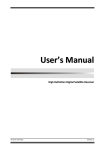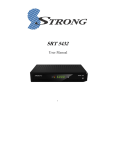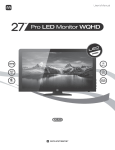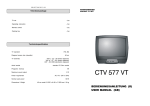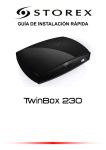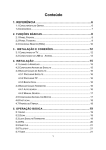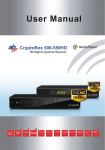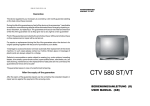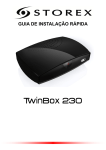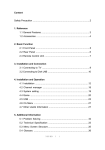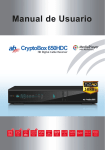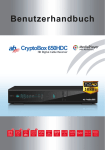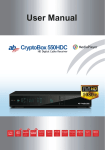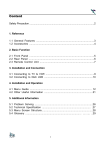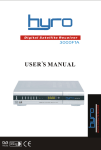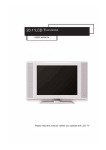Download User`s Manual
Transcript
User’s Manual High Definition Digital Satellite Receiver Model ID: HD X406p 03/2012 ak Content Safety Precaution .............................................................................................. 3 Environment protection……………………………………………………………… 4 1. General information ····························································································· 5 1.1 General Features ······················································································ 5 1.2 Accessories ······························································································· 6 2. Product Overview ································································································ 7 2.1 Front Panel ······························································································· 7 2.2 Rear Panel ································································································ 8 2.3 Remote Control Unit (RCU) ······································································ 9 3. Connection with other Devices ·········································································· 11 3.1 Connecting to TV ···················································································· 11 3.2 Connecting to Antenna ············································································ 12 4. Installation ········································································································· 14 4.1 Powering On ··························································································· 14 4.2 Antenna Settings ····················································································· 14 4.3 Factory Default ························································································ 20 4.4 USALS Setup ·························································································· 21 5. Edit Channel ······································································································ 22 5.1 Edit Channel ··························································································· 22 5.2 Edit Favorite ···························································································· 24 5.3 User Channel List···················································································· 25 6. Settings ············································································································· 25 6.1 System Settings ······················································································ 25 6.2 OSD Setup ······························································································ 27 6.3 Parental control ······················································································· 27 6.4 CA menu ································································································· 28 6.5 CI menu ·································································································· 28 7. Times ················································································································· 29 7.1 Time Settings ·························································································· 29 1 7.2 Event Timer ····························································································· 29 7.3 Sleep Timer ····························································································· 30 7.4 Standby hour ··························································································· 31 8. Expansion ·········································································································· 32 8.1 Games ···································································································· 32 8.2 USB········································································································· 32 8.2.1 Basic Operations ·················································································· 32 9. About STB ········································································································· 38 10. Basic Operation ······························································································· 39 10.1 Audio ····································································································· 39 10.2 Zoom In ································································································· 39 10.3 Satellite List ··························································································· 39 10.4 EPG ······································································································ 40 10.5 Subtitle ·································································································· 41 10.6 Teletext ·································································································· 41 10.7 Find channel·························································································· 41 10.8 Program Information ············································································· 42 11. Channel List ····································································································· 44 11.1 OK List··································································································· 44 11.2 Favorite List ························································································ 45 12. USB Control ···································································································· 46 12.1 Recording and Timeshift ······································································· 46 12.2 PVR List ································································································ 47 13. Network ··········································································································· 48 13.1 Connecting to Network ·········································································· 48 13.2 Connecting to Wifi (Wireless LAN) - OPTIONAL ··································· 48 13.3 Network Application··············································································· 49 14. Additional Information ······················································································ 50 14.1 Trouble Shooting ··················································································· 50 14.2 Declaration of conformity ······································································ 52 14.3 Technical Specification ·········································································· 53 2 Safety Precautions This STB has been designed and manufactured to satisfy the international safety standards. Please read the following safety precautions carefully before operating this receiver. Main Supply: Before operating, please check the units operating voltage is 90~250V AC 50/60Hz. Overload: Do not overload a wall outlet, extension cord or adapter, neither use damaged power cord or touch it with wet hand as this may result in electric shock. Liquid: The receiver shall not be exposed to dripping or splashing water, and that no objects filled with liquids, such as base, shall be placed on the apparatus. Ventilation: Keep the slots on top of the receiver uncover to allow sufficient airflow to the unit. Do not put the receiver on soft furnishings or carpets. Do not expose the receiver to direct light or do not place it near a heater or in humid conditions. Do not stack other electronic equipments on top of the receiver. Cleaning: Plug out the receiver from the wall outlet before cleaning. Clean the receiver by a soft cloth or mild solution of washing-up liquid (no solvents). Connection: Disconnect the receiver from the mains when you connect it to satellite LNB or disconnect it from LNB. Failure would possibly cause damage to the LNB. Location: Put the receiver indoor in order to avoid lightening, raining or sunlight. Uncover: Do not remove the cover, to reduce the risk of electric shock. Contact qualified and licensed service personnel to repair the receiver, or contact your dealer. 3 Environment protection Attention! Your product Is marked with this symbol. It means that used electrical and electronic products should not be mixed with general household waste. There is a separate collection system for these products. Information on Disposal for Users (private households) in the European Union Used electrical and electronic equipment must be treated separately and In accordance with legislation that requires proper treatment, recovery and recycling of used electrical and electronic equipment. Following the implementation by member states, private households within the EU states may return their used electrical and electronic equipment to designated collection facilities free of charge*. In some countries* your local retailer may also take back your old product free of charge if you purchase a similar new one. *) Please contact your local authority for further details. If your used electrical or electronic equipment has batteries or accumulators, please dispose of these separately beforehand according to local requirements. By disposing of this product correctly you will help ensure that the waste undergoes the necessary treatment, recovery and recycling and thus prevent potential negative effects on the environment and human health which could otherwise arise due to inappropriate waste handling. Information on Disposal for Business Users In the European Union If the product is used for business purposes and you want to discard It: Please contact your dealer who will inform you about the take-back of the product. You might be charged for the costs arising from take-back and recycling Small products (and small amounts) might be taken back by your local collection facilities, In other Countries outside the EU If you wish to discard of this product, please contact your local authorities and ask for the correct method of disposal. 4 1. General information 1.1 General Features DVB-S/DVB-S2 Satellite Compliant (MPEG-II/ MPEG-IV/ H.264) SCPC & MCPC receivable from Ku and C band satellites Universal, Single, Single S & C Band Wideband LNB Sensitive Tuner with Loop-Through DiSEqC1.0/1.1/1.2/1.3 (USALS) Unicable Supported Blind search supported Auto DiSEqC Search PAL/NTSC Conversion True full Color (32 bits) on screen display (OSD) Storing memory: 100 satellite, 4000 transponders and 6100 channels 8 favorite group and parental lock supported Multi-language menu supported Multi-language audio supported Multi-language DVB Subtitle output 7 days Electronic Program Guide (EPG) Teletext output through VBI and OSD USB 2.0 Interface 5 1.2 Accessories - Users manual - Remote Control Unit - Batteries Figure 1.Accessories 6 2. Product Overview 2.1 Front Panel Figure 2. Front Panel 1. Signal LED (green) Signal indicator. 2. Power LED (red) Power indicator 3. Display It displays channel information. In standby mode it displays current time. Press front panel on the middle, above LED display, to open front panel flap. Figure 3. Internal Front Panel 1. USB Port USB 2.0 port 7 2. Power button Switch between operation and standby modes. 3. MENU Button Activate the main menu in viewing mode. 4. Exit Button Exit current menu one menu level per one pressing. 5. OK Button Enters to the highlighted sub menu in menu mode or activates the channel list in viewing mode. [6,7]. VOL-/VOL+ Decrease / increase the volume in viewing mode and change settings in menu mode. [8,9]. CH-/CH+ Change channel in viewing mode and move the cursor up/down in menu mode. Card reader: Insert Conax Smart Card with golden pins down Common Interface: One slot for for Conditional Access Module (CAM) 2.2 Rear Panel Figure 3. Rear Panel 1 . AUDIO/ VIDEO OUT Connect to the TV using a RCA cable. 2. 0/12V OUT 0/12V power output. 3. LOOP OUT 8 Connect another receiver. 4. LNB IN Connect the satellite antenna cable. 5. ON/OFF Power on/off. 6. LAN Connect to the internet using an Ethernet cable. 7. SPDIF Digital Audio output (Optical). 8. TV SCART Connect to the TV using a Scart cable 9. HDMI Connect to the TV using an HDMI cable. 10. USB2.0 USB 2.0 Host Port. 2.3 Remote Control Unit (RCU) You can control this receiver by this remote controller with full function. 1. TV/R: Switch between TV and RADIO. 2. POWER: Switch between operation and standby modes. 3. MUTE: Mute audio. 4. DISPLAY: Set the HDMI mode. 5. MODE: Set the display format. 6. TIME: Setup event timer. 7. SLEEP: Set the sleep time. 8. NUMERIC KEY (0~9): Enter a TV/radio channel number or menu option number. 9. ZOOM: Picture zooming function. 10. SUBT: Display available subtitle language list. 11. AUDIO: Display available audio list. 9 Figure 4. Remote Control Unit 12. FAV: Display favorite channel list you set before. 13. SAT: Show the scanned satellite list. 14. RECALL: Move to the previous viewed channel. 15. EPG (Electronic Program Guide): Display the program guide. 16. EXIT: Exit current menu step by step. 17. CH+/CH-: Change program. 18. VOL+/VOL- : Change volume in viewing mode. 19. OK: Confirm the selected operation or display the channel list while watching a program. 20. MENU: Enter to main menu. 21. TXT: Display the teletext. 22. FIND: Quickly find channels which you want. 23. INFO: Display program information. 24. : Play recorder file, resume from Pause or display recording list 25. I I : Pause/time shift. 26. ■: Stop Recording, stop playback or exit from timeshift. 27.●: Start Recording. 28. I: Previous. 29. I : Next. 30. : Fast rewind. 31. : Fast forward. 32. USB: Enter to USB menu. 33. F1/F2/F3/F4/F5: Optional functions. 34. /: Page up/down in menu. 10 3. Connection with other Devices The following diagram shows the connections among receiver, TV, LNB and other equipment, please read this first if you are not sure about correct connection. 3.1 Connecting to TV Figure 5. Connecting to TV & VCR 11 3.2 Connecting to Antenna To connect to the dish with one single LNB, plug-in antenna cable directly to the LNB IN. Figure6. Connecting to Dish with single LNB 12 To connect to the dish with more than one LNB, connect antennas by DiSEqC 1.0 or 1.1 switch. Connect receiver LNB IN to DiSEqC port output. When using DiSEqC 1.0 or 1.1 switch, remember to set proper DiSEqC port in Installation Menu. Figure7. Connecting to Dish with many LNBs using DiSEqC switch 13 4. Installation After connecting antenna you should install the receiver after powering on your product for the first time after purchase. Tip: The default password is 0000. If you have forgotten your password, please contact your local product distributor. 4.1 Powering On 1. Connect the power cord of the product to a wall outlet. 2. Ensure the ON/OFF switch at the rear of the product is switched to ON. 3. Power on by pressing the STANDBY button on the remote control or the STANDBY button at the front of the product. 4.2 Antenna Settings Antenna Settings allows you to configure the antenna setting parameters. Menu->INTALLATION->Antenna Settings 1. Satellite: Displays currently chosen satellite. Press the VOL+/VOL- button to change. 2. Transponder (TP for short): Press the VOL+/VOL- button to change the TP. 3. LNB Type: Press the VOL+/VOLbutton to change the LNB frequency. 14 4. LNB Power: Press the VOL+/VOL- button to select the required LNB power. 5. 22kHz: Press the VOL+/VOL- button to select ON, OFF or Auto. 6. DiSEqC 1.0: Press the VOL+/VOL- button to select the required DiSEqC1.0 input. 7. DiSEqC 1.1: Press the VOL+/VOL- button to select the required DiSEqC1.1 input. 8. Motor: Press the VOL+/VOL- button to select DiSEqC1.2 or USALS motor. 9.Scan Mode: : Press the VOL+/VOL- button to choose available scan options: All Channels/FTA channels/HD channels/ SD channels/ TV channels/ Radio channels/ FTA TV channels/ FTA Radio channels/ 10. Start search: Press the VOL+/VOL- button to select Satellite & Multi-Sat & Blind scan & Transponder & Multi-Transponder which you want to start search. 4.2.1 Antenna Settings for Satellite Move cursor to Satellite position. Press OK button. You can see the pre-stored Satellite list. In this menu, you can execute Select, Add, Move, Delete, Rename Satellites by pressing VOL+/VOL- button. Select In this menu, you can press the CH+/CH- keys choose the satellite which you want to use, and then press the OK to confirm the setting. Add Select the Add using the VOL+/VOLkeys. Here you can input new Satellite angle, Satellite Direction (East, West), Band (Ku, C). Press OK to confirm the setting and this new satellite will be added to the end of the Satellite list. Move 15 In this menu, you can Select the satellite that you want to move from the satellite list using the CH+/CH- keys. Select satellite and press OK, you will be asked where to move the satellite, input the destination number and press OK. Then you can move another one satellite from one position to other. Delete You can delete unused satellites. Select the satellite that you want to delete from the satellite list. You will be asked to confirm whether delete the satellite or not. If you select YES, all the channels and transponders in the selected satellite will be deleted. Press OK key, and the selected satellite will be deleted. Rename You can also change the satellite name. Select the Rename using the VOL+/VOL- keys. Press OK key and select the character which you want to edit the name. Confirm by pressing BLUE button. 4.2.2 Antenna Settings for Transponder If you change the satellite, the transponders list will be changed automatically. You will find the transponder list of selected satellite here. In this menu, Press the VOL+/VOL- or OK button you can see the pre-stored Transponder list, and you can execute Select, Add, Delete, Edit Transponders by VOL+/VOL- keys. Select In this menu, you can press the CH+/CH- keys choose the 16 Transponder which you want to use, then press OK to confirm the setting. Add Here you can input new Transponder frequency, choose polarization (Vertical, Horizontal), input new Symbol rate, and choose FEC: 1/2, 2/3, 3/4, 6/5, 7/8, Auto . Press OK to confirm the settings, and this new Transponder will be added to the TP list in ascending order sorted by frequency. Delete You can delete the Transponder of the Satellite. Select the Transponder that you want to delete from the TP list. You will be asked to confirm whether delete the Transponder or not. If you select YES, all the channels in the selected Transponder will be deleted. Press OK key, and the selected Transponder will be deleted. Edit In this menu, you can press the CH+/CH- keys choose the Transponder which you want to Edit, press OK to confirm. Here you can change the Transponder frequency, polarization (Ver, Hor), symbol rate and FEC, then press OK to confirm your new settings. 4.2.3 Search Channels from Satellite A: Satellite Search 1. Highlight the Satellite position and press the OK button to enter satellite list. Select one satellite you want to search. 2. Complete the antenna settings of this satellite. 3. Highlight the Start Search and select satellite then press the OK button to confirm. B: Multi Satellites Search 1. Highlight the Start Search and select Multi-sat then press the OK button. 2. Highlight the satellites in the satellite list, but make sure they are all configured to 17 your DiSEqC Switch before press the OK to mark them. 3. Press Exit will start searching programs of the satellites you have marked. C: Blind Search 1. Highlight the Satellite and press the OK button to enter satellite list. And then select one satellite you want to search. 2. Complete the antenna settings of this satellite. 3. Highlight the Start Search and select Blind Search then press the OK button to confirm. D: TP Search 1. Highlight the Satellite and press the OK button to enter satellite list. And then select one satellite you want to search. 2. Complete the antenna setting of this satellite. 3. Highlight the Transponder and press the OK button to enter TP list. And then select one transponder you want search. 4. Highlight the Start Search and select Transponder then press the OK button to confirm. E: Multi TP Search 1. Highlight the Satellite and press the OK button to enter satellite list. And then select one satellite you want to search. 2. Complete the antenna setting of this satellite. 3. Highlight the Start Search and select Multi-Transponder then press the OK button to confirm. 4. Highlight the transponders in the TP list press the OK to mark them. 5. Press Exit will start searching programs of the transponders you have marked. 18 4.2.4 Antenna Settings for Motor Menu-> INTALLATION ->Antenna Settings->Motor 1. Motor Mode: Select DiSEqC 1.2 or USALS using the VOL+/VOL- button. DiSEqC 1.2: General motor antenna using DiSEqC 1.2. USALS: Motor antenna using USALS system. Move Auto[W/E] Press VOL+/VOL- button, the dish will be motorized to East/West continuously, it will stop until it find the best signal. Move west-east Press VOL+/VOL- button, the dish will be motorized to East/West step by step, until you find the best signal showed on the signal bar. Fine Tuning(1) Input digital button to set the moving step Store Position Save the current position you searched. Go to Position Press OK button to move the dish to the position which you saved. 19 Go to Reference Press OK button to move the dish to 0 position. Set West Limit You can set the maximum motor limit for both West to prevent damage to the antenna. Set East Limit You can set the maximum motor limit for both East to prevent damage to the antenna. Disable Limit Disable West limit and East limit. Go to X.X Press OK button to move the dish to the USALS Setup. Tip: Before you use USALS, you should go to Main Menu → SETTINGS→ USALS Setup to set you local position firstly. 4.3 Factory Default In case of any difficulties or wrong settings, You can restore the product to the factory default settings. Warning: Please note that once you perform Factory Default ->All, all data and settings will be deleted. 1. Menu->INSTALLTION -> Factory Default 2. Input the password. Default password is 0000. In case password was changed, input your own password. 20 3. Highlight the option you want and press the OK button to execute it. 1) All: All data and settings will be deleted. Tip: If you select “yes”, all data and setting will be lost. Then waiting a moment, you will view the OSD language menu where you can select the language according your mind. 2) Channel List Only: All channels data will be deleted. 3) Radio Channel Only: All radio channels data will be deleted. 4) Scramble Channel Only: All scramble channels data will be deleted. 4.4 USALS Setup Menu->Satellite->USALS Setup If you set the Motor Mode to USALS, you need set the longitude and the latitude in USALS Setup. Setup By Country: Press the Red button, you can choose the country, press OK button, you will view the city in this country that’s you select. 21 5. Edit Channel 5.1 Edit Channel Menu Edit Channels enables to move, delete, rename, lock/unlock, swap the channels in the channel list conveniently. Menu->EDIT CHANNEL->TV Channels Menu->EDIT CHANNEL-> Radio Channels Tip: Radio Channels operation similar to the TV Channels. Tip: in Edit Channel->TV channels you can press the Sat button to choose different satellite according to the help information, press OK to confirm, then all the channels of this sat will be displayed. 1. Move Channels 1) Highlight the Move function using VOL+/ VOL- button and Press OK to enter. 2) Highlight the channel you want to move and press OK to select the channel. You will see move sign instead of channel number. 3) Press the CH+/CH- button to move to new destination on the channel list and press the OK button, or press the NUMERIC(0-9) buttons to send channel to new destination in the channel list and press the OK button. 22 1.1 Move Group Channels 1) Highlight one channel you want to group move. Then press the RED button to mark the channel. 2) Press the CH+/CH- or VOL+/ VOL- button to highlight other channels you want to group move. Then press the RED button to sign the channel one by one. 3) Press the CH+/CH- or VOL+/ VOL- button to the new destination in the channel list and press OK to confirm. Marked channels will be placed in this position. 2. Delete Channels 1) Highlight the Delete function using VOL+/ VOL- button. 2) Press the CH+/CH- to highlight the channel you want to delete, press the OK button to sign the channel. 3) Press the EXIT button, select Yes in confirmation window to delete chosen channels. 3. Lock/unlock Channels Note: before using Channels lock, go to Menu->SETTINGS->Parental Control, change position Edit Channel Lock to YES. 1) Highlight the Lock function using VOL+/ VOL- button. 2) Highlight the channel you want to lock, press the OK button to confirm. 3) Input the password to lock the channel. If you want to lock another channel, you will not be asked to Input the password again until you press EXIT. Note: If the highlighted channel is locked, press the OK button is switched into Unlock. 4. Rename Channels 1) Highlight the Rename function using VOL+/ VOL- button. 2) Highlight the channel you want to rename, press the OK button. 3) Enter a channel name directly using the keyboard displayed on the screen and 23 press the BLUE button to complete. 5. Swap Channels 1) Highlight the Swap function using VOL+/ VOL- button. 2) Highlight the channel you want to swap with another. 3) Press the OK button to confirm. 4) Input new position of a channel and press OK. Channels position will be replaced. 5.2 Edit Favorite Menu->EDIT CHANNEL-> Favorites You can add or remove channels from the favorite groups. 1. Press the VOL+/VOL- button to change the favorite group . 2. Highlight the channels you want to add or remove from that favorite channel list and press the OK button. to mark the channel as selected favorite group. 3. Press RED key to rename favorite group. 4. Press the EXIT button to exit the menu and save it. 5. You can access favorite list by pressing FAV button on remote. Note: to change order of channels inside favorite lists, press FAV button, choose FAV list you want to modify order and press GREEN button to Edit order of channels. Note: If you select a favorite list, press the CH+/CH- button can only change the channels in this favorite list and press the OK button can only display the channels 24 in this favorite list. To exit from FAV list press OK button to display list, and press CH+/CH- button until you switch to All channels position. 5.3 User Channel List User Channel List allows you to save or load all the data and settings. 1. Menu->EDIT CHANNEL -> User Channel List->Save User Data 2. Menu-> EDIT CHANNEL -> User Channel List->Load User Data 6. Settings 6.1 System Settings Menu->SETTINGS->System Settings 1. Menu Language: Set the menu language. 2. Audio1: Set the preferred audio language. 3. Audio2: Set the sub-prime audio language. 4. Subtitle language: set the language of subtitles. 25 5. Teletext language: set the language of Teletext. 6. Digital Audio: If a channel has AC3 and PCM audio language at the same time, when you select RAW it will set AC3 audio language as default output and when you select PCM it will set PCM audio language as default output. 7. SCART output: you can choose between different SCART video signal output: CVBS and RGB 8. Auto Channel Selection: If you set ON, in the channel list will play automatically when you highlight the channel. If you set OFF, in the channel list when you highlight the channel, you should press the OK button to play it. 9. Auto Exit CH List: If you set ON, the channel list will disappear when you press OK on a Highlighted channel. If you set OFF, the channel list will disappear when you press OK on a playing channel. Note: move the coursor down to see another part of menu. 10. Recall List: You can turn Recall List on or off. If you set ON, when you press Recall button of RCU you can get the recall list of all programs recently watched. If you set OFF, when you press recall button you can go back to the last program you have selected. 11. Low Power Standby: If you set ON, when standby the power consumption is low when standby. If you set OFF, when standby the power consumption is same as power on. 26 12. Front panel Light: Allows to adjust setting of 4-digit LED display on front panel. There are 5 brightness levels available. 6.2 OSD Setup Menu->SETTINGS->OSD Setup 1. Menu Transparency: Set the transparency of all menus. 2. TXT Transparency: Set the transparency of teletext. 3. Display Mode: Set the HD screen resolution format between 1080p, 1080i, 720p, 576i or 576p. You can also change this setting by pressing DISPLAY button on remote, while watching TV. 4. TV Type: Set the TV Type on PAL/NTSC/Auto state. 5. Screen Mode: Set the display format according to the screen ratio. Select TV screen mode either 4:3 or 16:9 according to the TV type, or press the MODE button of RCU directly. 6. OSD Timeout: Set the time of disappearing OSD items, for example when switching channels. 6.3 Parental control Menu->SETTINGS->Parental Control 1. Password Lock: General enabling/disabling of all receivers locks 2. Installation Lock: By choosing YES, you can set password for entering to main menu functions. 3. Edit Channel Lock: By choosing YES, you can enable locking channels in channel edit menu. 4. Age Rating: allow to set protection level. Warning! This function depends on information from signal, in case no information function will not work! 27 5. Change PIN: allow to change PIN. Input new PIN and confirm it by inputting again. Remember your new PIN. 6.4 CA menu Receiver provides one Conditional Access slot for Smart Card. Receiver has build in module with CONAX system. By using cards in this system provided by operators, it is possible to watch many scrambled channels coded in this system. This menu shows detailed information about card inserted into card reader module. Insert Card with golden pins down. Note: All information showed in this menu and submenu are coming from inserted card. In case if anything is wrong, it could be card problem. After inserting the card correctly at any time, a message-box will show on the screen with message about detecting the card, in "card info" menu all available information will be displayed. 6.5 CI menu Receiver provides one Common Interface slot . Using different CAMs & cards provided by different CAS operator, you can view many type of scrambled channels. In this menu you can see the detail information of the CAM & card inserted in the slot. Note: All information showed in this menu and submenu is coming from CAM & card. In case something is wrong, it may be the problem of CAM or card. When you insert the CAM correctly at any time, a message will show on the screen with information which CAM has been detected by the receiver and if it is available now. 28 7. Times 7.1 Time Settings Menu->TIMES->Time Settings Time Settings will set the time mode, time zone and summer time. 1.Time Mode You can switch the Time Mode to Auto or Manual by pressing VOL+/VOLbutton. If the Time Mode is Manual you can change the current time and current date. 2. Time Offset Set the time zone according to your country/city. 3. Summer Time If summer time is used, correct the current time by pressing ON by VOL+/VOLbutton. 7.2 Event Timer Event Timer You can set timer events. 29 It will record or play the program automatically according to the timer event settings. 1. To add timer press Menu->TIMES-> Event Timer->(RED) Add, or in EPG menu press RED button or during watching press TIME button directly. 2. Press the RED button to setup a timer, and press the OK button to save the timer after setup. Channel: Select the Channel from Channel List. Date: Input start date of the timer. Start/Stop: Set Start time and Stop time of the timer. Repeat: <1X> only one time. <Day> Repeat every day. <1 Week> Repeat the channel once a week. <1-5> Repeat the channel from Monday to Friday. <6-7> Repeat the channel from Saturday to Sunday. Standby when Stop If set YES, the receiver will go to standby mode after the timer, if set NO it won’t be standby. Record: If set YES, only if there is a USB device, it will be recorded automatically when the timer is started. And the recorded PVR will be saved in USB device. If set NO, event will not be recorded, just receiver will switch to set channel. 3. In Event Timer menu, highlight one event, press the YELLOW button will cancel this timer and press the GREEN button can go to edit this timer. 7.3 Sleep Timer 30 SLEEP Timer can set the automatic turn off receiver after selected time. 1. Menu->TIMES-> Sleep Timer. 2. Press the VOL+/VOL- button to select the option or input the number at “-- M” option. 3. Press the OK button to save. 7.4 Standby hour Standby hour can show current time on front panel display in standby mode. 1. Menu->TIMES-> Standby hour. 2. Press the VOL+/VOL- button to select the option. If set ON, the current time will shown on the front panel when standby. 3. Press the OK button to save. 31 8. Expansion 8.1 Games Menu->EXPANSION-> Games This menu offers many funny games you can play. 8.2 USB Menu->EXPANSION-> USB or press the USB button directly With USB you can play many kinds of media files, you can record programs and playback it and you can do various operations when using USB HDD or USB disk. Note: receiver supports FAT, FAT32 and NTFS format USB disk or USB HDD. For recording programs use high speed USB device. Using too slow USB devices can cause that recorded files will be useless. 8.2.1 Basic Operations 1. Tool Rename Files 1) Highlight the file or folder. 2) Press the RED button and Highlight the Rename. 3) Press the OK button can rename the file or folder. Delete Files 1) Highlight the file or folder. 32 2) Press the RED button and Highlight the Delete. 3) Press the OK button can delete the file or folder. Move Files 1) Highlight the file or folder. 2) Press the RED button and Highlight the Move to. 3) Select a destination folder. 4) Press the OK button to move the highlight folder or file to destination folder. Copy Files 1) Highlight the file or folder. 2) Press the RED button and Highlight the Copy to. 3) Select another disk partition. 4) Press the OK button to copy the highlight folder or file to disk partition which you selected. Create New Folder 1) Press the RED button and Highlight the Create New Folder. 2) Press the OK button to create a new folder in current folder Sort 1) Press the RED button and Highlight the Sort. 2) Select the sort type. (First Name/Date/Size) 3) Press the OK button to sort by sort type which you selected. Format Disk 1) Highlight a disk partition or enter a disk partition. 2) Press the RED button and Highlight the Format Disk. 3) Press the OK button and then select a format mode (Fat and NTFS). Then press OK button to confirm format. Warning! After formatting, all the files in current disk partition will be irreversibly lost. 2. Upload Upload Data to USB (channels database) 1) Enter the USB disk. 2) Press the YELLOW button and highlight the Upload Data to USB. 33 3) Press the OK button can upload the data and setting to USB disk. Upload to FTP (Optional) 1) Highlight the file or folder. 2) Press the YELLOW button and highlight the Upload to FTP. 3) Press the OK button can upload the highlight file or folder to FTP. Note: this function depend on FTP server. Make sure you configure properly server connection and your FTP server support it. 8.2.2 Setting 1. Play Mode Loop Set the Loop state on Normal, Reverse, Random, Single or Off. Slide Show Interval Set the Slide Show Interval from 2S-10S. Photo View Mode Set the Photo View Mode state on Full Screen, 2x2 Thumbnail or 2x3 Thumbnail. 2. PVR Setting Record Partition Select the Partition where save your record or other result of your operation. Record Mode Set the Record Mode Channel or Transponder. For standard recording set it to Channel. Record Type Set the Record Type TS or PS. 34 Record Time Set the Record Default Time Off, 30, 60, 90, 120 minute or input number directly. Auto Timeshift Set to start the Timeshift automatically, after every switching channel. Timeshift Buffer Size(MB) Set the Timeshift Buffer Size off, Auto, 100, 200, 400, 800, 1600, 3200, 6400MB. Timeshift Need Save Set the Timeshift if need to Save . Play Start Pos When playing the recorded file, set the Play Start Pos to start playback from beginning of the file or from last watched position (if before stopped to play by manual exiting). FTP Upload (optional) Set the stream of recording whether upload to FTP or not. 8.2.3 Play Files 1. Music 1) Press the VOL+/VOL- to highlight the Music. 2) Press the CH+/CH- to change the folder or file and press the OK button to open the folder or play the music file. It supports *.ogg, *.wav and *.flac format music files. OK: Play the selected file. CH+/CH-: Change the highlighted item. : Play the file. 35 ■ : Stop playing file. I: Play the previous file. I: Play the next file. : Fast rewind. : Fast forward. PAUSE/||: Pause. VOL+/VOL- : Adjust volume. EXIT: Exit playing state and return to file list menu. 2. Photo 1) Press the VOL+/VOL- to highlight the Photo. 2) Press the CH+/CH- to change the folder or file and press the OK button to open the folder or play the picture. It supports *.bmp, *.jpg, and *.gif format photos. Tip: You can press the Green button to go to Play Mode Set the Photo View Mode state on Full Screen, 2x2 Thumbnail or 2x3 Thumbnail in the USB menu. The picture followed is 2x2 Thumbnail mode. OK: View the photo. CH+/CH-/VOL+/VOL-: Highlighted the previous/next photo when photo view mode is 2x2 Thumbnail or 2x3 Thumbnail. VOL+/VOL- button also can rotate the picture when photo display of full screen. I: Play the previous file. I: Play the next file. PAUSE/||: Pause. ZOOM: Zoom in pictures, the zooms change as follows: x1 ->x2->x4 ->x8 ->x16 ->x1. EXIT: Exit the current menu. 36 3. PVR 1) Press the VOL+/VOL- to highlight the PVR. 2) Press the CH+/CH- to change the folder or file and press the OK button to open the folder or play the PVR file. Note:. Recorded files are saved as default in folder named ALIDVRS2. OK: View play list or play the highlighted file in the play list. : Display playing progress. PAUSE/||: Pause or Step. ■: Stop playing file. : Fast rewind. : Fast forward. I or CH+: Play the previous item, from the recorded programs list. I or CH-: Play the next item, from the recorded programs list. INFO: Display playing progress. In this menu, press the INFO button again to display the EPG information. AUDIO: Set the audio language. (OPTIONAL) SUB: If the file has subtitle, press the SUB button can change the subtitle. TXT: If the file has teletext, press the TXT button can display the teletext. Find or (0-9): Jump to the valid time that you input. VOL+/VOL-: Jump to forward or rewind of a time interval when info bar display. Page Up: Mark on current time when info bar display. Page Down: Jump to mark when info bar display. EXIT: Exit the current menu. 4. Play List You can play the movie/photo/music/PVR files in the Play List. 1) In the USB Menu highlight a photo/music/PVR file and press the FAV button to mark it, then press the GREEN button to enter the Play List menu, you will see the files marked included in play 37 list. 2) In the photo/music Play List, press FAV key to add the all available files to the Play List. (Just according to the help information) 3) In the movie/ photo/music Play List, highlight the movie/photo/music file and press the Red button to mark it, then move it to the destination press OK to confirm, then you can move the marked file to destination. 4) Press the GREEN button set the Play Mode. 5) Press Yellow key to delete highlighted file from Play List. 6) Press the BLUE button to delete all files from Play list. 9. About STB Menu->ABOUT STB In this menu you can find useful information about the STB, such as product name, software version, hardware version. When you need service from the dealer you need to submit this information in order to get the correct and fast after sales service. 38 10. Basic Operation 10.1 Audio You can select the language you prefer in Audio if the current program is available in multiple audio languages. 1. Press the AUDIO button. 2. Press the OK button to select the audio language you prefer. 3. Select audio direction (Left, Right, Stereo) using the VOL+/VOL- button. 4. Press the EXIT button to close. 10.2 Zoom In You can zoom in the current video picture. 1. Press the ZOOM button. 2. Press the CH+/CH-/VOL+/VOL- button to move the icon to the position you want to zoom in. 3. Press the OK button to display. 4. Press the EXIT button to close. 10.3 Satellite List You can select or hide the satellite that you want. 39 1. Press the SAT button. 2. Highlight the satellite that you want. 3. Press the OK button, then it can enter the channel list which only includes the channels of this satellite. 4. Press the RED button to hide or show the satellite. If it is hidden, the channels of this satellite will be hidden in the channel list. 5. Press the Green button to delete the satellite. And all the channels in this satellite will be deleted. 10.4 EPG You can view the EPG information of all channels in time and date order. 1. Press the EPG button. 2. Press the GREEN button to switch EPG mode between Weekly EPG and Day EPG. Weekly EPG: 1) Press the CH+/CH- button to change EPG event. 2) Press the VOL+/VOL- button to change the date, and it displays the EPG list in one day of the selected channel. 3) Highlight the EPG event which you want, press the RED button to enter Timer Setup menu. After setup, press the OK button can add the EPG event to the Timer. Day EPG: 40 1) Press the CH+/CH- button to change channel. 2) Press the VOL+/VOL- button to change EPG event of the highlighted channel. 3) Press the BLUE button to display the detail information of the highlighted EPG event. 4) Highlight the EPG event which you want, press the RED button to enter Timer Setup menu. After setup, press the OK button can add the EPG event to the Timer. 10.5 Subtitle You can select the language for the subtitle if the program provides subtitle information. 1. Press the SUB button. 2. Select the required subtitle language and press the OK button. The subtitle of the selected language will be displayed at the bottom of the screen. 10.6 Teletext You can view the teletext information of currently watched program. 1. Press the TXT button. 2. Press the CH+/CH- button to page up or page down. 3. Press the NUMERIC(0-9) buttons can go to the designated page directly. 4. Press the color button can back to the previous page. 10.7 Find channel You can find the channels you want quickly just by pressing the FIND button directly. 41 Or by pressing Blue button in OK List/FAV List. 10.8 Program Information You can view the program information by pressing the INFO button while watching a program. 1. General Information : It is a FTA program. : It is a scramble program. : The sound of current program is not Dolby. : The sound of current program is Dolby. : Current program has no EPG information. : Current program has EPG information. : Current program has no teletext information. : Current program has teletext information. : Current program is unlocked. 42 : Current program is locked. : Current program is not a HD program. : Current program is a HD program. 2. EPG Information Press the INFO button twice to view detailed EPG information, press the VOL+/VOL- to switch current and next and press the INFO button once more to hide the detailed EPG information. 43 11. Channel List This chapter will help you manipulate the channel list. Tip: You can press the Sat button to choose different satellite when you are operating on a channel list, press OK to confirm, then all the channels of this sat will be display. 11.1 OK List 1) Press the OK button to enter the channel list while watching a program. 2) Press the VOL+/VOL- button to switch the channel list type. (All Channels/ FTA Channels/ Scramble Channels/ HD Channels) 2) Press the RED button to sort the channels. Highlight the option you want and press the OK button to sort the channel list. Note: The Original Channel List is back to the channel list you sort it last time. 3) Press the GREEN button to list the channels by transponder. 4) Press the YELLOW button can help you find the channel quick by the first character of name. 5) Press the BLUE button to enter the Quick Find menu. 44 11.2 Favorite List 1) If you have set several favorite lists, press the FAV button can enter the favorite list. 2) Press the VOL+/VOL- button to change different favorite list and press the OK button can select the a program in current favorite list. 3) Press the RED button to sort the channels of the favorite list. 4) Press the GREEN button to manipulate the favorite list channels (move, delete, rename, lock/unlock, swap the channels of the favorite list) . 5) Press the YELLOW button can help you find out channels quick by their first name. 6) Press the BLUE button can help you quickly find the channel you want. Note: If you selected a favorite list, press the CH+/CH- button can only change the channels in this favorite list and press the OK button can only display the channels in this favorite list. 45 12. USB Control 12.1 Recording and Timeshift 12.1.1 Recording You can watch another channel from the same TP while recording. And at the same time, you can record two channels in the same TP. You can also do many operations while recording. 1. Start Recording 1) You can press the ● button to start recording while watching program. 2) You can switch to another channel and press the ● button to start the second recording. 3) If you have set the timer, and set the Time Record on, it will start recording automatically according to the start time of the timer. 2. Stop Recording 1) You can press the ■ button to stop recording. If you don’t press the ■ button, it will stop recording according to the record duration. 2) If you have set the timer, it will stop recording automatically according to the stop time of the timer. 3) If the free space on the USB HDD or USB disk is insufficient, recording will stop. 3. Watch the Other Program while Recording At the same time, you can only watch the program from the same TP. 4. Other Operations while Recording While the recording channel is current channel, press the INFO button can display 46 the recording time. And press the INFO button twice can display the detail information of the recording. Press the button will enter the playback mode. Press the ● button can set the record duration. Press the PAUSE/|| button can pause or play the program. Press the / button can fast rewind or fast forward in playback mode. 12.1.2 Timeshift Timeshift allows you to pause a live broadcast and return to it later and continue where you left off. Press the || button to start timeshift. While it is in timeshift mode, press the button can play the program, press the INFO button can display the recording information, press the PAUSE/|| button can pause or play the program, press the / button can fast rewind or fast forward. Press the ■ button to stop timeshift. If you change to another program or do other operations, timeshift data will be deleted. If automatic timeshift is set, after switching channel, receiver will start timeshift again. 12.2 PVR List You can enter the PVR list directly and then play the PVR file. In the PVR list you also can delete the PVR files. 1. Press button enter the PVR list when watching program. 2. Press the CH+/CH- to highlight the PVR file you want to play, press the OK button to play in small screen. 3. You can press BLUE button to play the PVR file in full screen. And press Exit button will return to the PVR List. 4. If you want to delete PVR files, first you must press the CH+/CH- to highlight the PVR file you want to delete, and press the YELLOW button to delete. 47 13. Network By connecting to internet you might have access to selected internet services. 13.1 Connecting to Network 13.1.1 Connecting to the LAN 1. Connect one end of the Ethernet cable to the product and the other end to the LAN router. 2. Menu->Expansion->IP Setting If the Ethernet cable is connected fine, it will display “Connect”. In this menu, you can set IP address manually, also you can get IP address automatically. RED: Get IP address automatically. GREEN: Test the network if connect correctly. 13.2 Connecting to Wifi (Wireless LAN) - OPTIONAL Note: this menu is available only after inserting Wifi dongle. After inserting dongle LAN by Ethernet cable will be disabled automatically. 1. Plug in the wireless USB dongle to the USB port. 2. Enter Menu->EXPANSION->Wireless Setting->Search Access Point. 3. Select the network name of your Wi-Fi access point from the list. 4. Press the OK button, then input 48 the right password. 5. Enter Menu-> Network->Wireless Setting->IP Situation. If the Network is connected, it should get the correct IP address and display the “Connected”. 13.3 Network Application 13.3.1 Weather Forecast Here you can input the city name to browse the weather of this city in future days. RED: Change the city and unit of temperature. GREEN: Store the current setting. 13.2.2 FTP Download (optional) You can Download S/W, music, photo and other media files from the FTP. 1. Menu-> Expansion ->FTP Download 2. Input the correct information for every option. 3. Highlight on the Connect Net, press the OK button to enter the FTP. 4. According to the prompted information select the file you want to download and press the OK button to download it to USB device. 49 14. Additional Information 14.1 Trouble Shooting Before contacting your local service centre, please read the tips below carefully. If the problem persists after completing the following procedure, please contact your local product distributor or service centre for further instructions. 1. No message displayed on the front display. (The product will not switch on, nothing on display) • Check the main power cable and make sure it is plugged into a suitable power outlet. • Check that the mains supply is switched on. • Connect the power cable to a different power outlet. • Check that the power switch is on at the rear of the product. (where applicable) 2. No picture • Make sure that the product is powered on and in operation mode. (Press the STANDBY button, in operating mode Display will show channel number, try to change channels) • Make sure that the AV/HDMI/YUV cable is firmly connected to the TV. Try to change Video resolution by pressing Display button. • Make sure that the antenna cable is properly connected to the product. • Be sure to activate channel search. • Check the brightness level of the TV. • Check if the channel is currently on air. Contact the broadcaster to ensure that the channel is running. 3. Poor picture/sound quality 50 • Make sure there is no mobile phone or microwave oven near the product. • Check that your dish alignment is correct. • Change the satellite dish for a larger one as this will increase the signal levels received. • Replace the LNB with a lower noise factor in cases where the noise factor is too high. • Replace the LNB with a new one in case it is damaged or out of order. • Check the signal levels and adjust your antenna if the level is too low. The signal level may be affected by weather conditions. 4. No or poor sound • Check that your AV/HDMI cable is connected correctly. • Check the volume levels of your TV set and the product. • Check if the product or TV is on mute. • Check audio type or soundtrack option. (where applicable) 5. Remote control does not operate. • To control the product, the top end of the remote control should point directly towards the receiving part of the product. • Remove and reinsert the batteries in the remote control. • Replace the batteries in the remote control for a new set. 6. Cannot connect to the network . • Make sure the network of your family is good. • Make sure the Ethernet cable is inserted firmly to the LAN router. • Make sure the Wi-Fi can work on other device (optional) • Input the Wi-Fi password again. (optional) • Get auto IP again. Press green button to test link. • Restart the receiver again. 51 14.2 Declaration of conformity The manufacturer herewith declares the conformity of that product with the following directives and standards: Low Voltage Directive 2006/95/EC EN 60065:2002+A1:2006+A11:2008 EMC Directive 2004/108/EC EN 55 013:2001+A1:2003+A2:2006 EN 55 020:2007 EN 61 000-3-2:2006+A1:2009+A2:2009 EN 61 000-3-3:2008 Model: Digital Satellite Receiver DVB-S2 52 14.3 Technical Specification Tuner & Channel Frequency Range 950 MHz to 2150 MHz Signal Level -25 to -65 dBm LNB Power 13V/18V/14V/19V OFF, Imax = 400mA LNB Tone Switch 22KHz+/-2KHz, 0.6Vpp+/-0.2V DiSEqC Control Version DiSEq C 1.0/1.1/1.2/1.3(USALS)Compatible, Tone burst A/B MPEG Transport Stream MPEG-2 ISO/IEC 13818Transport stream specification Profile Level MPEG1,MPEG-2 MP@ML,H.264, Input Rate 80 Mbps for MPEG Transport Stream and 25 Mbps for DV streams Aspect Ratio 4:3, 16:9 Video Resolution 576i, 576p, 480i, 480p, 720p50, 1080i, 1080p Audio Decoding MPEG-2 layer I and II (Music cam),MPEG4 AAC and MPEG4 AAC-HE (AAC+),Dolby Digital (AC-3) with bit rates up to 640 K bits /s, LPCM up to 48 KHz, Audio Mode Single channel/Dual channel/Joint stereo/Stereo Sampling 32, 44.1 and 48 KHz Power Supply Input Voltage AC 100 ~240V, 50/60Hz Power Consumption StandBy mode <1W, Operation mode 15W, Protection Separate internal fuse. Input shall have lightening Protection Max load 25W Physical Specification Weight (Net) About 2.5kg Operating Temp 0℃ to + 40℃ Storage Temp -40℃ to + 65℃ Weight and dimensions are not absolutely exact values. In order to improve the product, specifications are subject to change (by manufacturer) without notice. 53






















































